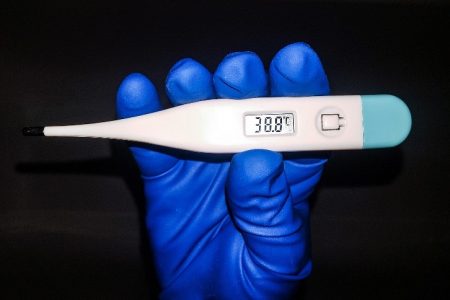Why TEGAM Advises Against Infrared and For Contact Thermometers for COVID-19 Testing
投稿 9月 14, 2020 によって Adam R. Fleder

Image courtesy of Wired.com
By Adam Fleder, President – Advanced Energy's TEGAM
“I would like to order a million infrared temperature sensors” is the kind of request that a temperature measurement company likes to hear. In the response to COVID-19, many people are looking for solutions to monitoring people’s temperature and we have fielded several of these inquiries. TEGAM specializes in contact temperature measurement as opposed to infrared temperature measurement and you can read about the differences and advantages of contact thermometers versus infrared thermometers.
However, we are a Test & Measurement company and are aware of the considerations that go into choosing between contact versus infrared and we would like to offer our own perspective on scanning people for elevated temperatures with an infrared detector.
Infrared energy is emitted by everything above absolute zero. The amount of radiation increases as the temperature increases and Infrared thermometers use this to estimate the temperature of the person, object or substance being tested. It sounds simple enough in concept but that’s where the cookie starts to crumble.
If your goal is to scan employees before starting a work shift at some facility, there are several concerns. The first is that there are some people who become infected with COVID-19 and won’t show any symptoms – such as a fever. Obviously, no temperature measurement system will detect these cases because these people do not display an above-average temperature. However, even though no preventative measure is 100% effective, it is still good practice to identify those who DO present with a fever before starting work.
Surface Temperature Versus Core
The next complication is that infrared thermometers measure the surface temperature of a person, not the core temperature. Many things can change a person’s surface temperature relative to their internal temperature. Did they just get out of a hot car? Did they have a long walk in a cold, windy parking lot. Were they wearing a scarf? I measure approximately a 5 ⁰F difference between my core temperature and that of my surface skin temperature when performing my own experiments with an infrared sensor!
Surface Emissivity
Surface conditions also influence temperature readings considerably – concern #3. Surfaces vary from shiny to rough and the amount of radiation varies with these differences. A shiny metal pan will measure 100s of degrees different compared to that of a black cast-iron skillet IF the surface emissivity is not adjusted. The same variation occurs in human skin although to a lesser degree. It is assumed to be the standard 0.98 but can vary by as much as 3% which can cause an error of +/- 1.5 ⁰F at human body temperatures. I have a facial birthmark and it causes a 1 ⁰F change between it and my normal pigment skin, for example.
Spot Size and Range
There is also the scope of the measurement to be considered. Infrared thermometers are designed to scan a certain area (spot size) at a certain distance (range). If the spot size is larger than the person’s face at the range at which you are measuring, it will average the full field of view – which may include background radiation off a wall or other inanimate objects. This influences the temperature reading!
Thermometer Accuracy
The final concern is that the infrared thermometer has its own inherent error. An accurate instrument will be +/- 1%, which is an additional degree of error at body temperature.
Total Error
We have now come to the place where we need to do some statistics. Let’s make two assumptions – the errors are random, and evenly distributed. If we do this, we can take the RSS (Root Sum Square) of the known errors and come up with a final estimate of error. Further, let’s assume that the measurement setup is correct for spot-size and range so that we can ignore that error. That leaves us with variations in conditions (2 ⁰F), surface emissivity (1.5 ⁰F) and accuracy (1 ⁰F). Error =2.7 ⁰F. The CDC recommends using 38 ⁰C or 100.4 ⁰F as the threshold for a reportable fever. Clearly with a standard body temperature of 98.6 ⁰F (37 ⁰C), a 2.7 ⁰F range of error can cause both false positives and negatives.
That might lead you to conclude that infrared is useless and that would be incorrect. You can reduce the error by controlling the initial conditions so that a person’s surface temperature is more consistent. Although it would not be as socially acceptable and would be riskier, you could scan the inside of a person’s mouth to get closer to a core temperature. Instead of focusing on the absolute reading, a differential technique could be applied that would select the highest 10% for secondary screening with a traditional oral thermometer.
COVID-19 has presented us with many challenges and as we reopen Society, temperature screening is just one line of defense in finding and containing the contagion. Hopefully our perspective helps you to choose the best temperature measurement solution for your application.
If you need to make contact temperature measurements, TEGAM has a full line of excellent, durable industrial thermometers, datalogging thermometers and temperature calibrators to serve your needs. We’re here to answer your questions and queries, thanks.
Need more information yet? Please read this additional blog post that can help you decide which thermometry tool is best for your needs – contact thermometers or distance, infrared thermometers.
Adam R. Fleder
Advanced Energy
